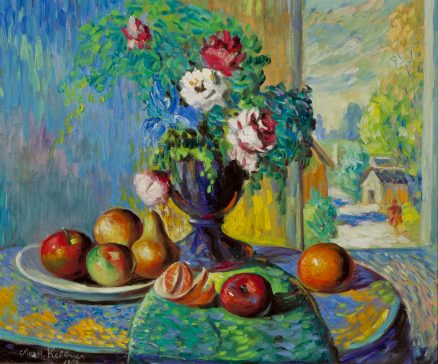- Categories
- Immigrant artists
- Still lifes
- Zoom in on Artwork
- Print Page
- Email Page to Friend
Charles Kellner’s brilliantly hued still-life composition features a tabletop arrangement of flowers and fruit, with a pleasant country landscape glimpsed as if through a window in the background. Kellner used distinct spots and strokes of pigment to create a highly textured surface further animated by tapestry-like patterns of contrasting hues. While the rounded forms of apples, oranges, and a pear are carefully modeled, other areas, notably the tabletop itself, are rendered primarily as accretions of actively applied pigment on the flat canvas.
Kellner worked mainly as a portraitist for much of his career, although he painted landscapes and still lifes from an early period, as demonstrated by the record of works on exhibit in his Sheridan Road studio in 1925. In his last decades, Kellner painted his still lifes with particular freedom, using static compositions of inanimate objects as vehicles for dynamic brushwork and dramatic color contrasts. This example unites his joint interests in still life and landscape, while stylistically invoking the artist’s early artistic mentors and inspirations. The painting’s vivid colorism reflects the influence of the early twentieth-century French artists known as the Fauves, notably Pierre Bonnard, with whom Kellner studied in 1919–1920. Particular areas of the composition seem to nod to other modern masters: the tapestry-like effect of interwoven blue, green, and lavender tints in the left background recalls Claude Monet’s late paintings of the Seine, for example, and the spotted paint with which Kellner rendered the tabletop, the swathe of blue-and-green fabric on it, and the undefined area in the composition’s the lower right corner seems an homage to the late works of Vincent van Gogh.
Wendy Greenhouse, PhD
Donated by M. Christine Schwartz to the Koehnline Museum of Art, Oakton Community College, Des Plaines, Illinois, in 2022
